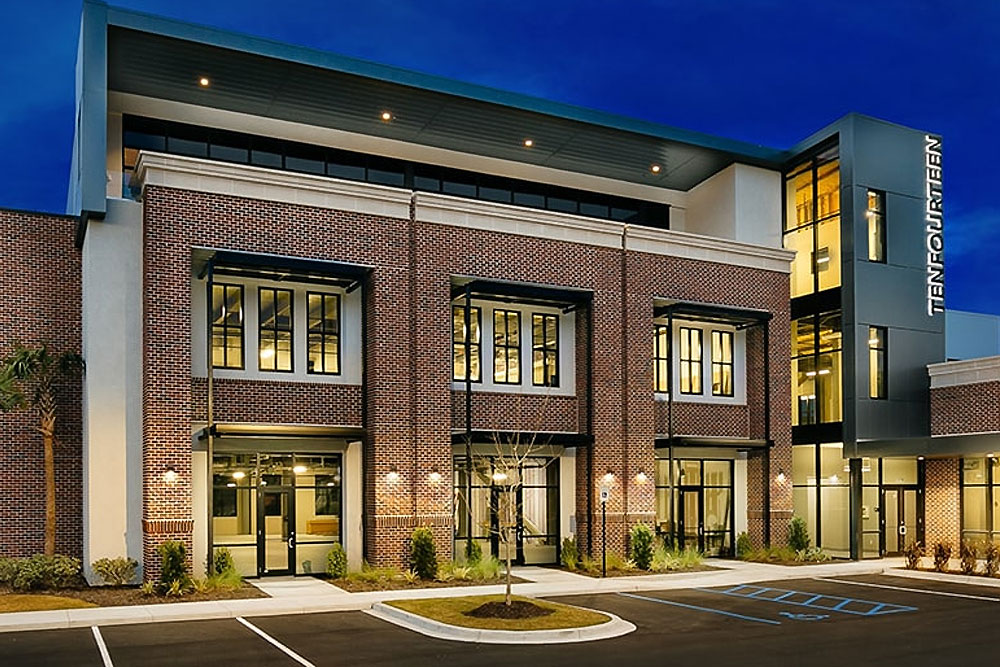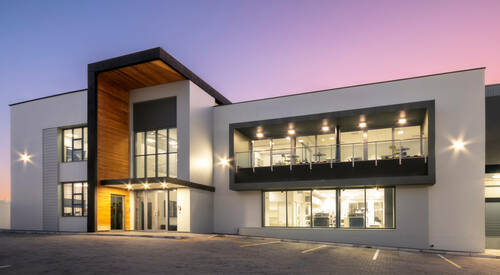Exactly How Commercial Architects Can Transform Your Organization Space With Professional Style Services
Commercial architects play an important role in reshaping organization settings. Their expertise in design can greatly boost both performance and aesthetics. By producing rooms that mirror a brand's identity, they boost functional performance and staff member satisfaction. However, the influence of their work expands past mere look. Comprehending the subtleties of collaboration and sustainability can lead to transformative results. What particular components make these improvements effective?
Understanding the Duty of Commercial Architects
Commercial architects play a crucial function fit company settings that are both useful and cosmetically pleasing. They specialize in developing rooms customized to the specific requirements of organizations, making certain that every square foot is made use of efficiently. These professionals incorporate components such as spatial format, lights, and materials to enhance efficiency and staff member wellness. By working together with clients, industrial architects gather insights into functional demands and brand name identity, converting these right into cutting-edge designs.Additionally, they browse complicated building codes and zoning laws, making certain compliance while taking full advantage of style possibility. Their expertise extends to sustainability practices, advertising energy efficiency and eco-friendly materials in their jobs. With their innovative vision and technical expertise, commercial architects not just produce attractive spaces however likewise foster settings that promote cooperation and growth. Ultimately, their payments substantially affect the general success and picture of an organization.
Advantages of Specialist Design Solutions

Tailoring Areas to Your Brand Identification
Tailoring rooms to a brand's identity is necessary for conveying its core values and mission. Commercial architects play a critical duty in enhancing an organization's visual identification via thoughtful style options. By lining up building aspects with brand name principles, business can produce settings that reverberate with customers and staff members alike.
Reflecting Brand Worths
Just how can a well-designed space personify a business's core values? Commercial architects play an important duty fit environments that resonate with a brand's identification. By incorporating components such as color schemes, products, and designs, they develop rooms that mirror the significance of the company. A technology business could decide for open layouts and modern home furnishings to communicate development and cooperation, while a deluxe brand name might pick sophisticated surfaces and intimate areas to stimulate exclusivity and refinement. Thoughtful design not just boosts capability yet also fosters a solid connection in between employees, customers, and the brand. Ultimately, a well-crafted setting acts as a concrete depiction of a firm's goal and vision, strengthening its worths at every touchpoint.
Enhancing Aesthetic Identity
What components can properly boost a brand's aesthetic identity within a commercial area? Commercial architects play an essential role in incorporating layout attributes that reverberate with a business's principles. Shade systems, typography, and materials can be strategically picked to reflect brand name values while making certain visual allure. Additionally, integrating logo designs and brand name imagery right into the architecture can develop a natural aesthetic story. Lighting design can better improve the atmosphere, directing consumer understandings and experiences (commercial architects). Layout and furniture selections should straighten with the brand name's personality, whether it's contemporary, traditional, or ingenious. Eventually, a well-designed commercial space not only brings in customers however additionally reinforces brand recognition, creating an enduring impression that promotes loyalty and involvement
Enhancing Performance and Performance
Enhancing capability and efficiency in commercial areas involves enhancing room usage and developing operations that streamline operations. Architects concentrate on producing formats that decrease thrown away area while helping with smooth adjustments in between jobs. This method not just enhances efficiency however likewise adds to a more cohesive workplace.
Maximizing Space Application
Effective room application is an important element in business design, where the layout has to stabilize visual appeals with performance (commercial architects). Architects employ various methods to optimize readily available square video footage while guaranteeing that each location serves a distinct function. By analyzing operations, website traffic patterns, and user requirements, architects can develop layouts that enhance both employee productivity and client experience. Multi-functional areas, adaptable furnishings arrangements, and maximized storage space remedies are essential components in accomplishing this goal. In addition, integrating natural light and open spaces cultivates a more inviting ambience, further raising the utility of the setting. Inevitably, effective space usage not just enhances functional performance however additionally contributes favorably to the overall brand name photo, making it an essential consideration in commercial style
Structured Workflow Style
Just how can a properly designed workflow change a business room right into a center of productivity? Streamlined workflow style concentrates on enhancing the physical format and functional procedures within a service atmosphere. By strategically setting up workstations, conference areas, and resources, architects can eliminate unnecessary motion and improve collaboration. This thoughtful layout minimizes diversions and facilitates interaction, enabling staff members to concentrate on their jobs a lot more successfully. On top of that, incorporating innovation into the workflow can further automate processes, reducing time spent on regular jobs. Consequently, businesses experience improved worker spirits and increased output, producing a vibrant ambience that promotes technology. Ultimately, purchasing streamlined process layout not only enhances performance yet additionally places a business space for lasting development and success.
Promoting Partnership Via Style
Modern-day work spaces often prioritize private productivity, the style of industrial rooms increasingly emphasizes cooperation as a key chauffeur of innovation and team communication. Architects play a crucial role in developing settings that promote interaction amongst staff members. Open formats, multifunctional areas, and tactically placed public areas encourage spontaneous discussions and conceptualizing sessions.Incorporating aspects such as movable furnishings and adaptable conference spaces enables teams to reconfigure rooms based upon their joint needs. Furthermore, integrating modern technology, like interactive whiteboards and video clip conferencing devices, boosts the ability to connect efficiently, no matter of location.Natural light and biophilic design components also add to an extra inviting environment, promoting convenience and wellness, which are important for efficient teamwork. By concentrating on these facets, business architects can produce dynamic settings that not just improve partnership yet also drive total company success.
Sustainable Design Practices in Commercial Architecture

Case Researches: Successful Changes by Commercial Architects
The execution of lasting design methods has not just reshaped the approach to industrial architecture yet has likewise resulted in remarkable improvements in various service spaces. One significant situation is the redesign of a technology business's headquarters, where architects integrated all-natural light and environment-friendly walls, leading to improved worker well-being and performance. This improvement reduced this hyperlink power costs by 30% and improved the company's public image.In one more circumstances, a store undertook a total overhaul, making use of reclaimed products and energy-efficient systems. This not only brought in eco-conscious customers however additionally boosted foot website traffic by 25%. A third situation involved a company workplace that embraced an open-plan layout with versatile work areas, promoting partnership among groups. The architects' focus on developing a dynamic and adaptable setting substantially enhanced employee complete satisfaction. These instance studies exhibit just how commercial architects can create impactful spaces that align with company goals and sustainability efforts.
Often Asked Questions
Just How Much Do Commercial Design Solutions Commonly Price?
The price of business style solutions varies widely, usually ranging from $100 to $250 per hour. Elements influencing pricing consist of task complexity, place, and the architect's experience, making it vital for companies to acquire in-depth quotes.
What Kinds Of Services Profit The Majority Of From Commercial Architects?
Numerous services, including retail, hospitality, and company workplaces, substantially advantage from business architects. These professionals improve performance, looks, and brand name identity, ensuring rooms are maximized for customer interaction and worker productivity, ultimately fostering company growth.
How much time Does an Industrial Style Job Typically Take?
The timeline for an industrial style project normally varies from several weeks to numerous months. Factors affecting duration consist of job intricacy, governing approvals, and cooperation amongst stakeholders, all of which can impact overall completion time.
Can I Work With a Commercial Designer for Restorations Just?
Yes, working with an industrial architect for improvements is possible. Several architects specialize in remodelling projects, supplying expertise in maximizing existing spaces while sticking to regulations and boosting functionality, aesthetic appeals, and overall value of business setting.
What Qualifications Should I Look for in an Industrial Architect?
